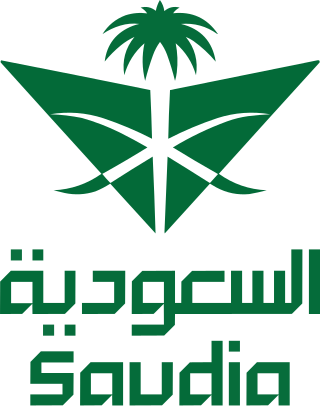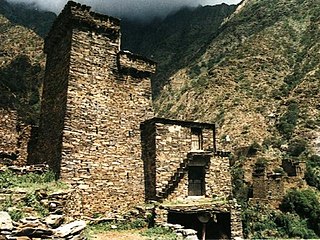
Saudia, formally known as Saudi Arabian Airlines, is the flag carrier of Saudi Arabia, based in Jeddah. The airline's main hub is at King Abdulaziz International Airport in Jeddah and King Khalid International Airport in Riyadh. It operates domestic and international scheduled flights to over 100 destinations in the Middle East, Africa, Asia, Europe and North America. Domestic and international charter flights are operated, mostly during the Ramadan and the Hajj season. It joined the SkyTeam airline alliance on 29 May 2012 becoming the first Arab Gulf carrier to join one of the three major airline alliances. Saudia is a member and one of the founders of the Arab Air Carriers' Organization.

The Eastern Province, also known as the Eastern Region, is the easternmost of the 13 provinces of Saudi Arabia. It is the largest province by area and the third most populous after the Riyadh Province and the Mecca Province. In 2017, the population was 4,900,325. Of these, 3,140,362 were Saudi citizens and 1,759,963 were foreign nationals The province accounts for 15.05% of the entire population of Saudi Arabia and is named for its geographical location relative to the rest of the kingdom.

Dammam is the fourth-most populous city in Saudi Arabia after Riyadh, Jeddah, and Mecca. It's the capital of the Eastern Province, with a total population of 1,532,300 as of 2022. The judicial and administrative bodies of the province, in addition to the administrative offices of other minor governmental departments functioning within the province, are located in the city. The word itself is generally used to refer to the city, but may also refer to its eponymous governorate.

King Abdulaziz Air Base, also known as Dhahran Air Base and formerly Dhahran International Airport, Dhahran Airport and Dhahran Airfield, is a Royal Saudi Air Force base located in Dhahran in the Eastern Province, Saudi Arabia. Located west of Thuqbah and 7 km (4 mi) southeast of the Saudi Aramco Dhahran Camp, the airbase was the first Saudi Arabian airport to be constructed, in 1961, and is under the command of Air vice-marshal Prince Turki bin Bandar bin Abdulaziz Al Saud.

King Abdulaziz International Airport (KAIA), also known as Jeddah International Airport, is an international airport serving Jeddah, Saudi Arabia.

King Fahd International Airport, also known as Dammam International Airport or simply Dammam Airport or King Fahd Airport, is the international airport serving Dammam, Saudi Arabia. The airport is located 31 kilometres northwest of downtown Dammam and is named after the former King of Saudi Arabia, Fahd ibn Abdulaziz (1921–2005). The airport serves the entire Eastern Province of Saudi Arabia and is one of the four primary international airports in the kingdom.

Prince Mohammad bin Abdulaziz International Airport or Medina Airport is a regional airport in Medina, Saudi Arabia. Opened in 1950, it handles domestic flights, while it has scheduled international services to regional destinations such as Cairo, Dubai, Istanbul and Kuwait City. Medina Airport also handles charter international flights during the Hajj and Umrah seasons. The Pilgrims for Hajj and Umrah can enter Saudi Arabia through this airport or through Jeddah Airport only. It is the fourth busiest airport in Saudi Arabia, handling 8,144,790 passengers in 2018.

The Saudi Railways Organization (SRO) was a state-owned railway company that operated part of Saudi Arabia's rail network, along with the Saudi Railway Company. The SRO operated a network of railways with a total length of approximately 1,380 kilometers. The network consisted of two main lines. A 449 km passenger line that links Dammam with Riyadh, and a 556 km freight line that connects the King Abdul Aziz Port in Dammam with Riyadh.

Articles related to Saudi Arabia include:
Gurayat Domestic Airport is an airport serving Gurayat, a city in Al Jawf Province, Saudi Arabia. It provides facilities for Saudia scheduled services to both Jeddah and Riyadh. The airport was established in 1974.
Qurayat is a city located in Al Jawf Province, in northern Saudi Arabia. It is 30 kilometres (19 mi) from border of Jordan. Qurayat had a population of 147,550 at the 2010 Census. It is a small city with a very big market. Qurayyat is known for its olives and salt.

Saudi Arabia is the second biggest tourist destination in the Middle East with over 16 million visiting in 2017. Although most tourism in Saudi Arabia still largely involves religious pilgrimages, there is growth in the leisure tourism sector. As the tourism sector has been largely boosted lately, the sector is expected to be the white oil for Saudi Arabia. This is proved as tourism sector is expected to generate $25 billion in 2019. Potential tourist areas include the Hijaz and Sarawat Mountains, Red Sea diving and a number of ancient ruins.

The Haramain High Speed Railway, also known as the Western railway or Mecca–Medina high-speed railway, is a 453-kilometre-long (281 mi) high-speed rail line in Saudi Arabia. It links the Muslim holy cities of Medina and Mecca via King Abdullah Economic City and Jeddah, using 449.2 kilometres (279.1 mi) of main line and a 3.75-kilometre (2.33 mi) branch connection to King Abdulaziz International Airport (KAIA), in Jeddah. The line was designed for a top speed of 350 km/h (220 mph), and with a service speed of 300 km/h (190 mph).

Rail transport in Saudi Arabia is an expanding mode of transport.

The SAR North–South Railway line is a 2,750 km network of railway lines in central and eastern Saudi Arabia, built and operated by the Saudi Railway Company. The primary line of the network connects the capital of the kingdom, Riyadh, to the border with Jordan at Al Hadithah.

Highway 40 is a major east–west six-lane controlled-access highway in Saudi Arabia, spanning 1,395 km. The highway connects Jeddah, the second-largest city in the kingdom, on the western coast of Saudi Arabia to Dammam, the sixth-largest city on the eastern coast and the largest in the Eastern Province. Apart from Jeddah and Dammam, Highway 40 also runs near or through Mecca, Ta'if, Riyadh, Abqaiq and Khobar along its length, and provides access to the Mahazat as-Sayd and Saja and Umm Al Ramth wildlife sanctuaries.

King Abdul Aziz Port, also known as Dammam Port, is a port in the city of Dammam, Saudi Arabia. It is the largest port in the Persian Gulf, and the third largest and third busiest port in the Middle East and North Africa (MENA) region, after the Jeddah Islamic Port. King Abdul Aziz Port is a major export center for the oil industry, and also a key distribution center for major landlocked cities in the country, particularly the capital cities of provinces, such as Riyadh which is linked to Dammam by a railway line.

Dammam Station is the railway station serving the city of Dammam. It is the eastern terminus of the Dammam–Riyadh Line and one of the three railway stations with active passenger transport in the Eastern Province. The station also serves as the station of operations for the Saudi Railway Company (SAR).























